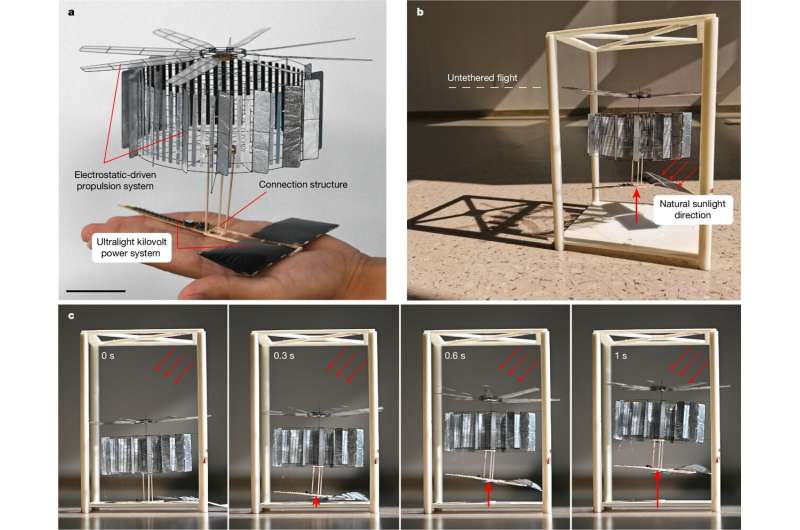
A team of engineers at Beihang University, working with a colleague from Center of Advanced Aero-Engine, both in China, has developed a micro-aerial vehicle that flies using direct sunlight. They reported their results in the journal Nature.
As drone technology matures, scientists and others have been finding new uses for them. One potential use is high-altitude surveillance. With the right technology, drones powered by the sun could be sent aloft and would never have to land, much like satellites, only at much lower altitudes.
Such drones would be so small that it would be nearly impossible to see or track them, or to shoot them down in a war. In this new study, the research team in China found a way to overcome some of the roadblocks that have stood in the way of developing such drones.
Currently, micro-aerial vehicles are limited in flight time to about a half hour. The smallest, called ultralight MAVs, can only fly for about 10 minutes. This is because electromagnetic motors are used to power them, using electricity from a solar panel. Unfortunately, the smaller the drone, the smaller the surface area of the solar panel. Also, smaller electromagnetic motors are less efficient.
To overcome these problems, the researchers used an electrostatic motor that powers a rotor using electrostatic fields. The approach allowed the team to build a motor weighing just 1.52 grams.
The motor was made by nesting a circle of electrode plates around a spinning cylinder hosting 64 rotor slats. The edges of the plates brush against the rotor slats as they spin. The rest of the drone was made by placing two solar cells below the motor connected by a spanner and a helicopter-type rotor above the motor connected by a thin axis.
When the drone is exposed to sunlight, the solar cells generate power, spinning the motor, which pushes the upper rotor, pulling the drone up into the air and holding it there. In tests, the drone was capable of sustained flight for at least an hour. The team plans to continue working with the drone to improve durability and increase payload size.
More information: Wei Shen et al, Sunlight-powered sustained flight of an ultralight micro aerial vehicle, Nature (2024). DOI: 10.1038/s41586-024-07609-4
© 2024 Science X Network
Citation: Tiny sunlight-powered drone flies for an hour (2024, July 18) retrieved 18 July 2024 from https://techxplore.com/news/2024-07-tiny-sunlight-powered-drone-flies.html
This document is subject to copyright. Apart from any fair dealing for the purpose of private study or research, no part may be reproduced without the written permission. The content is provided for information purposes only.
